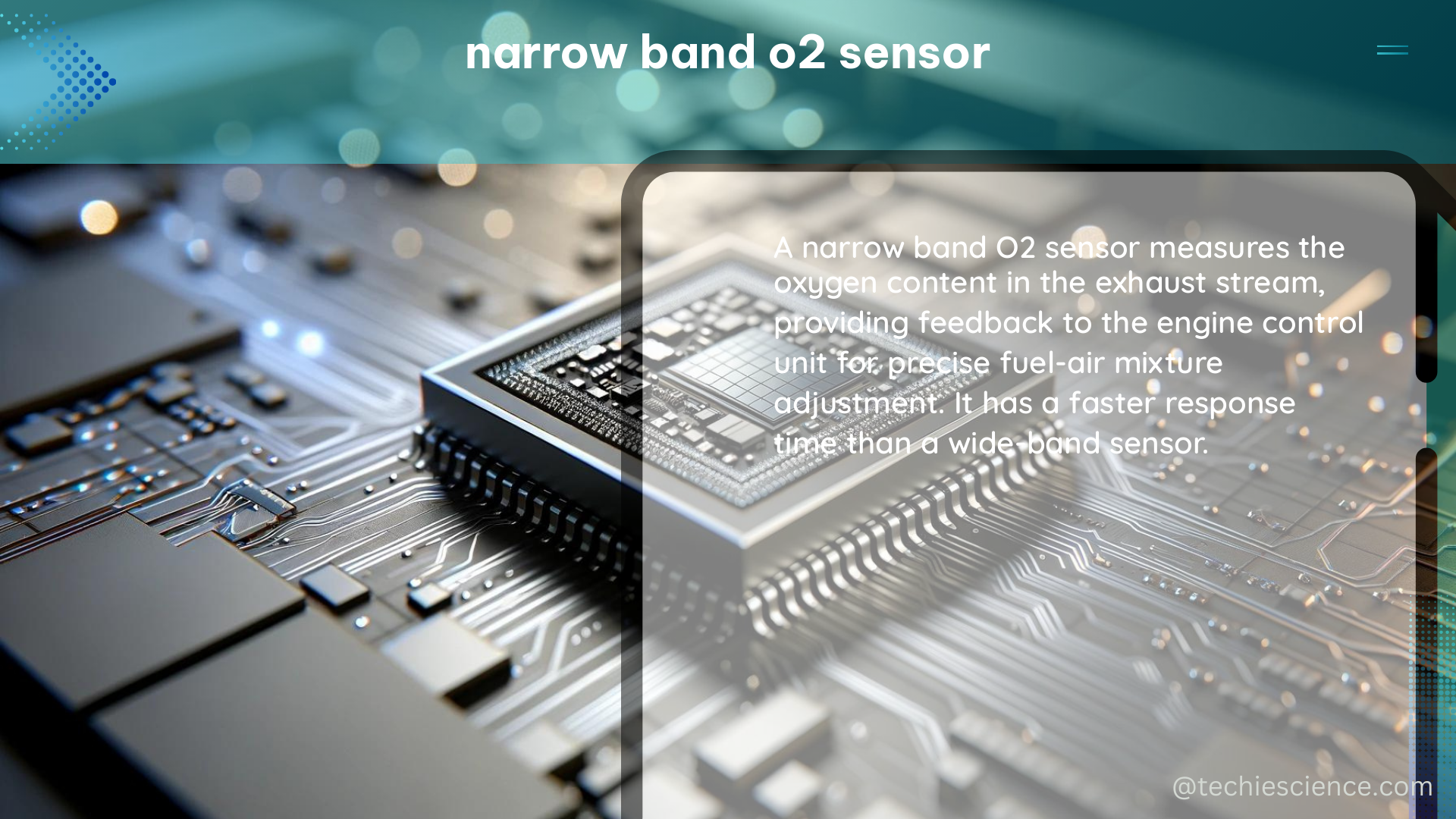Narrow band oxygen sensors, also known as narrow band O2 sensors or just O2 sensors, are a crucial component in modern automotive engines’ fuel management systems. They measure the oxygen content in the exhaust gases and provide feedback to the engine control unit (ECU) to adjust the air-fuel mixture, ensuring optimal engine performance and efficiency.
Sensor Type and Operation
Narrow band O2 sensors typically use a zirconia ceramic element that generates a voltage output based on the amount of oxygen present in the exhaust gases. The sensor operates on the principle of electrochemical potential, where the difference in oxygen concentration between the exhaust gas and the reference air (usually the ambient air) creates a voltage signal.
When the air-fuel mixture is lean (excess oxygen), the sensor output voltage is low, around 0.1V. Conversely, when the mixture is rich (less oxygen), the sensor output voltage increases to around 0.9V. This on/off signal is used by the ECU to make real-time adjustments to the fuel injection system, ensuring the engine operates at the optimal air-fuel ratio.
Lambda Measurement and Stoichiometry

Narrow band O2 sensors measure the air-fuel ratio (AFR) in terms of lambda (λ), which is a dimensionless value that represents the ratio of the actual air-fuel ratio to the stoichiometric air-fuel ratio. A lambda value of 1 represents a stoichiometric mixture, where the AFR is ideal for complete combustion (14.7:1 for gasoline engines).
Narrow band sensors can only accurately measure lambda values close to 1, typically within the range of 0.8 to 1.2. This limited measurement range is a key limitation of narrow band sensors, as they cannot provide precise feedback for air-fuel ratios significantly above or below the stoichiometric point.
Temperature Requirements and Heating Elements
Narrow band O2 sensors require a specific operating temperature range, typically between 300°C and 600°C, to function properly. This temperature range is necessary for the sensor’s electrochemical reactions to occur and generate the voltage signal.
To help the sensor reach its operating temperature quickly, many narrow band O2 sensors are equipped with integrated heating elements. These heating elements, often made of ceramic or metallic materials, are powered by the vehicle’s electrical system and help the sensor warm up rapidly, even during cold starts or low-load conditions.
Response Time and Transient Conditions
Compared to wideband O2 sensors, narrow band sensors have a slower response time. They typically take several seconds to switch between the low and high voltage outputs, which can lead to inaccurate readings during rapid transient conditions, such as sudden changes in engine load or throttle position.
This slower response time can be a limitation in applications where the engine experiences frequent and rapid changes in operating conditions, as the narrow band sensor may not be able to provide the ECU with the necessary feedback in a timely manner. In such cases, wideband O2 sensors may be a more suitable choice.
Installation Location and Positioning
Narrow band O2 sensors are typically installed close to the exhaust manifold, where the exhaust gases are hottest. This location allows the sensor to reach its operating temperature quickly and provide accurate readings. However, some applications may require the sensor to be installed further downstream in the exhaust system, such as when packaging constraints or other design considerations dictate a different sensor placement.
The positioning of the narrow band O2 sensor within the exhaust system can also affect its performance. Factors such as exhaust gas flow patterns, turbulence, and temperature gradients can influence the sensor’s ability to accurately measure the oxygen content. Proper sensor placement and orientation are crucial for ensuring reliable and consistent feedback to the ECU.
Sensor Lifespan and Degradation
Narrow band O2 sensors typically have a lifespan of around 30,000 to 50,000 miles, depending on the operating conditions and vehicle maintenance. Over time, the sensor’s sensitivity may decrease due to factors such as exposure to high temperatures, exhaust contaminants, and mechanical stress.
As the sensor ages, its ability to accurately measure the air-fuel ratio may diminish, leading to inaccurate readings and the need for replacement. Regular inspection and replacement of the narrow band O2 sensor, as recommended by the vehicle manufacturer, are essential for maintaining optimal engine performance and fuel efficiency.
Conclusion
Narrow band O2 sensors play a vital role in the fuel management systems of modern automotive engines. By understanding their operating principles, measurement capabilities, and limitations, technicians and enthusiasts can better optimize the performance and longevity of these critical components. This comprehensive guide has provided a detailed overview of the key characteristics and considerations surrounding narrow band O2 sensors, equipping you with the knowledge to effectively diagnose, maintain, and troubleshoot these essential engine management devices.
References:
- Honda-Tech Forum: O2 Sensor Trick
- HP Academy Forum: Narrow Band Tuning Range Using Narrow Band Sensors
- HP Tuners Forum: Narrow Band Tuning
- Bosch Automotive Handbook
- SAE International: Oxygen Sensor Fundamentals

The lambdageeks.com Core SME Team is a group of experienced subject matter experts from diverse scientific and technical fields including Physics, Chemistry, Technology,Electronics & Electrical Engineering, Automotive, Mechanical Engineering. Our team collaborates to create high-quality, well-researched articles on a wide range of science and technology topics for the lambdageeks.com website.
All Our Senior SME are having more than 7 Years of experience in the respective fields . They are either Working Industry Professionals or assocaited With different Universities. Refer Our Authors Page to get to know About our Core SMEs.